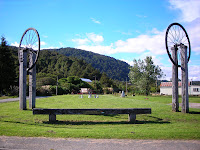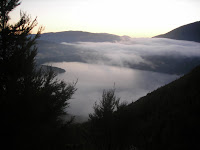In our trip, we passed through Greymouth, with a dangerously turbulent river harbor, and Blackball, which now has more streets than it does people, but was once the fireplace of the labor union that began in the coalmines of the town. We stopped for a few days in Reefton, “The Town of Light.” The coal extracted here supplied the first electric streetlights in New Zealand. The motor camp we stayed in was home to a number of new workers who could not afford housing in the city, yet.


From Reefton we traveled north back across the divide to Nelson Lakes. This national park is the site of a mainland island, where the Department of Conservation (DoC) is attempting to exclude all pests and restore the native ecosystems. For class we walked a small nature trail, but a number of us would be left here for our four day “spring break.”


That night, St. Patrick’s Day if you were wondering, we stayed at the DoC campsite on the north side Kerr Bay in Lake Rotoiti. The next morning five of us pushed out west around the lake with the intention of reaching the summit of Mt. Roberts and then continuing on towards Lake Angelus. The road to Mt. Roberts was significantly more steep and taxing than planned, keep in mind we are carrying our packs with four days of four season gear. By 2p we made it to the top of Mt. Roberts, my highest summit thus far at 1421 m. Getting to the trailhead was an accomplishment in and of itself, so getting, here was exhausting. One of our crew suffered from a migraine and heat exhaustion. Luckily a friend from Israel passed by the shelter she took for a nap and was able to suggest a nearby hut to use for the night. So it would be the Bushline Hut overlooking Lake Rotoiti for the night…damn?!?! There we met Brian who was the former Crown Advisor of Criminology. The conversation that night was nothing short of stimulating. It is also worth noting that I did not stay in the hut, but slept on the mossy floor of the beech forest just outside the hut.


The next day we set out just with daypacks along Roberts Ridge to Lake Angelus. Halfway there we climbed to the top of the adjacent peak to Julius’s Summit, 1813 m. That is a bit shorter than Mt. Washington in New Hampshire. It was one of the most exciting moments of my life, and the echo was ridiculous. Lake Angelus was no less magical. We got there about 11:30a and had a few hours to lounge around the alpine lake before we headed back to view the sunset from the ridge. Mind you there was no swimming as the water was virtually freezing. I was not able to feel my feet after a brief dunking. There we met a few people from the states, including Larry from Detroit, who was surprised to find out that there still was a Michigan Marching Band, some Michigander he is. I also met Winston who claimed he was from a small southern European nation, but was unavoidably Swiss by his accent.


The climb down from the Bushline Hut was fairly uneventful and only took a few hours. From Nelson Lakes, we hitched with a Czech man on working holiday to the city of Nelson. This is by far the New Zealand city with the best atmosphere that I have seen so far. However, it being Good Friday and all, most shops were closed. We stayed at the hippest hostel there, the Palace. Some nightlife was had, and a day “excursion” to a bone carver took up our time in Nelson.

We were picked up by the Ecoquest vans and headed off to Picton to board, once again, the Interislander. That night was spent in Hutt Valley. We were given a chance to go to Wellington for a few hours, and there I participated in something I never had planned even through that morning. At Westpac stadium, I was a part of Rock 2 Wellington. The line-up: Lordi, Alice Cooper, and Kiss…no joke. It was a weak crowd, but that didn’t stop me and a friend, James, from being rocked out by the time Kiss left the stage. To bad I wasn’t there to see Poison, White Snake, and Ozzy Osborne the next night.
Well I hope that is enough for you, because that is about all I have for my South Island Experience. The rest of the ride back was uneventful and I am now safe and sound back in Kaiaua. This week is spent locally viewing shorebirds. Until the next time I have something exciting to write about…keep and eye out for some movies that might get posted from this series. Cheers!

















